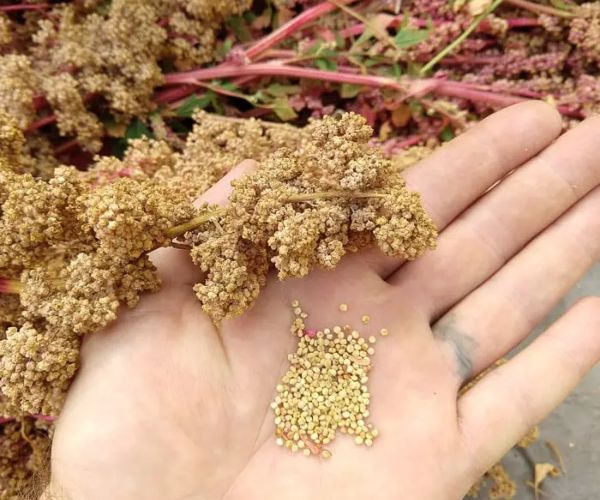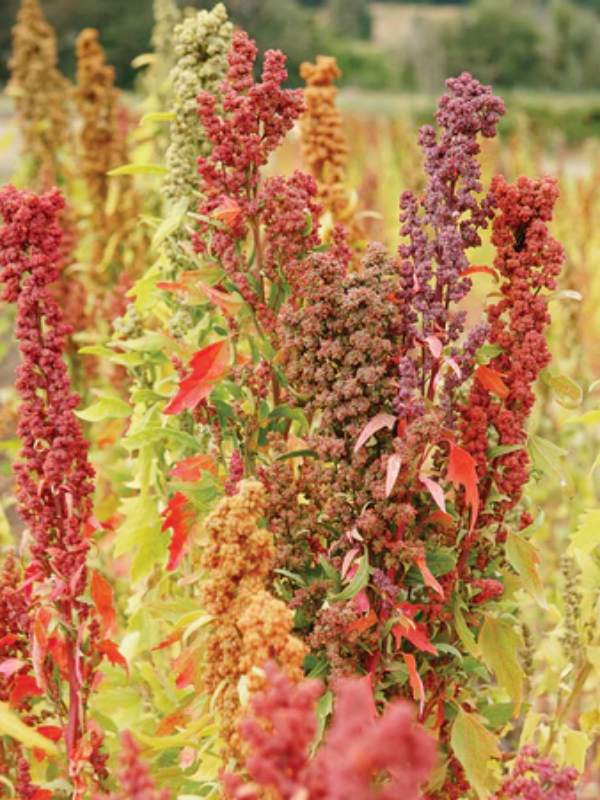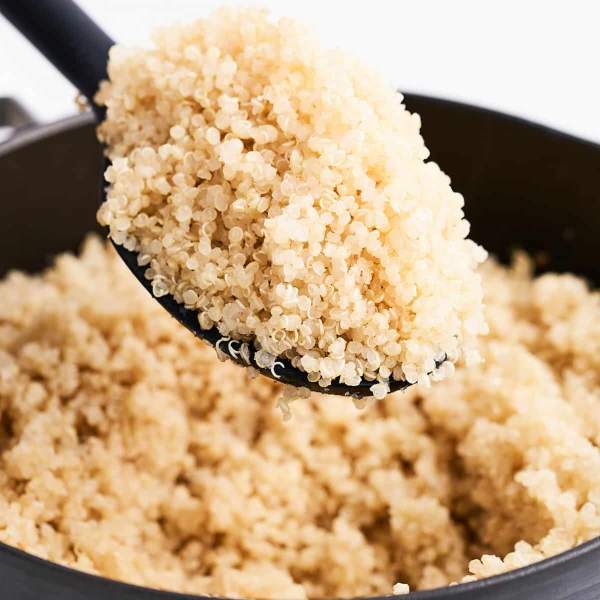Quinoa is an edible grain crop with a lot of nourishment. Seeds can be used for cooking, just like rice, or ground into flour to replace wheat, as a gluten-free option. It is native to the Andean region of South America. Quinoa is considered one of the most healthy foods because it contains a high content of protein, fiber, vitamins, and minerals. This plant will grow to 6 feet tall and produce small seeds that look like beads. The seeds can be white, red, or black.
Plant Description
Plant Type: Herbaceous, Annual, Vegetable
Scientific Name: Chenopodium quinoa
Family: Amaranthaceae
Genus: Chenopodium
Species: C. quinoa
Season: Summer
Native Area: South America
What makes Quinoa so special?
In recent years, quinoa has become very popular as people look for easy-to-grow, nutritious, gluten-free grain options. Quinoa is packed with nutrients like protein, zinc, fiber, folate, and antioxidants, which make it very healthy and beneficial for overall well-being.
1 Cup Quinoa Nutrition Facts
- Calories: 222
- Protein: 8 grams
- Fat: 3.55 grams
- Carbohydrates: 39 grams
- Fiber: 5 grams
- Folate: 19 %of the daily value (DV)
- Vitamin B6: 13% of the DV
- Vitamin E: 8% of the DV
- Copper: 39% of the DV
- Iron: 15% of the DV
- Zinc: 18% of the DV
- Manganese: 51% of the DV
- Magnesium: 28% of the DV
- Potassium: 7% of the DV
- Phosphorus: 22% of the DV

Health Benefits of Quinoa
- Quinoa contains quercetin and kaempferol compounds that contribute to the reduction of inflammation and cell protection from damage.
- It has a higher content of fiber in comparison with most grains.
- It is naturally gluten-free. Hence it is a good health option for those who avoid gluten.
- Quinoa is a better protein source as compared to other grains, but it is not considered to be a complete protein as it contains low levels of some amino acids, for example, leucine and lysine.
- Besides that, it also contains various types of vitamins and minerals in it. Consuming Quinoa will help benefit your metabolism and heart health.
Types of Quinoa
Brightest Brilliant
Brightest Brilliant grows edible seeds but is popular as an ornamental plant for borders due to its colorful appearance. It grows about 4 feet tall and produces flower stalks in orange, pink, burgundy, white, and yellow. Besides, this variety is deer-resistant.
Red Head Organic Quinoa
Red Head Organic Quinoa is a robust and high-yielding variety known for its edible white seeds. It grows pinkish-red flowers and seeds that look like fluffy clouds. This variety does well in dry, arid climates.
Biobio
Biobio quinoa produces vibrant pink flower clusters that turn into white seeds. Native to Chile, this variety is known for its rapid growth and high seed yield.
Cherry Vanilla
This variety produces a cluster of flower heads ranging in color from cream to pink. This plant grows to a height of 3 to 5 feet. Cherry Vanilla is suitable as both an ornamental border and a grain.

Growing and Caring Tips for Quinoa
Light
Choose a very sunny location to grow quinoa. It needs a minimum of 8 hours of direct sunlight per day, although it might also do well given some shade in the hottest part of the day.
Soil Preparation
Quinoa does best in well-drained, fertile soil. Another important tip is to add some organic fertilizer to the soil before planting. Afterward, when the seedlings are a few inches tall, mulch the area around the plants to retain moisture in the soil, prevent excessive weed growth, and provide better temperature stability for optimal growth.
Watering
Quinoa seedlings like constant moisture to help the seeds sprout. However, avoid waterlogged. As the plants mature, water them during dry periods but let the top few inches of soil dry out between waterings.
Temperature and Humidity
It requires average temperatures with low humidity. Quinoa grows well at temperatures between 95°F, but high temperatures and humidity above this will reduce the growth of the plant and seed production.
Fertilizer
This grain can grow well in poor soil and usually doesn’t need extra fertilizer. You can, however, add some nutrients by mixing compost into the soil when you plant if you want.
Pruning
Pruning quinoa plants is generally not necessary. However, you might need to cut off a few leaves if your plant gets top-heavy and starts falling over so that it stays erect.
Pests and Diseases
Weeds are the major problem for quinoa plants. Some weeds, such as thistle and mustard, may attract aphids that have bad effects on them. Likewise, its leaves can be infested with flea beetles and leaf miners. To prevent this, you can put a 2-inch layer of shredded wood mulch or any other organic mulch around the plant.
Propagating Method of Quinoa from Seed

Sowing Time: Quinoa seeds can be sown directly into the garden after the last frost. You can sow seeds in late summer or early fall for a winter harvest.
Soil Preparation: Prepare the soil before sowing by mixing fresh compost into the soil. The ground needs to be at a temperature of about 60°F for the seeds to germinate.
Planting the seeds: Once the soil is ready, spread the seeds in your garden and pat it with a thin layer of soil. Then, lightly spray the top to keep it moist.
Spacing: The spacing of the plants is very important. Make rows of sowing 12 inches apart and within each row, the seeds should be 2 inches apart. Also, have 2-3 seeds in each spot to ensure at least one seedling grows.
Watering and Lighting: Ensure that the plants receive a sufficient amount of sun for healthy growth. Water the seeds and seedlings regularly to keep them consistently moist until they are well-established.
Harvest Time: Quinoa seeds germinate in about 4-5 days. After sowing, the plants mature within 90-120 days before one can harvest them.
Also read, Low maintenance Garden border Ideas || Best plants for garden edges
Frequently Asked Questions
1. What plant is Quinoa?
Quinoa is an edible grain crop with a lot of nourishment. Seeds can be used for cooking, just like rice, or ground into flour to replace wheat, as a gluten-free option.
2. Where does the Quinoa grow?
Quinoa does best in well-drained, fertile soil. Choose a very sunny location to grow it. It needs a minimum of 8 hours of direct sunlight per day.
3. What are the benefits of growing quinoa?
This Grain is considered one of the most healthy foods because it contains a high content of protein, fiber, vitamins, and minerals.
